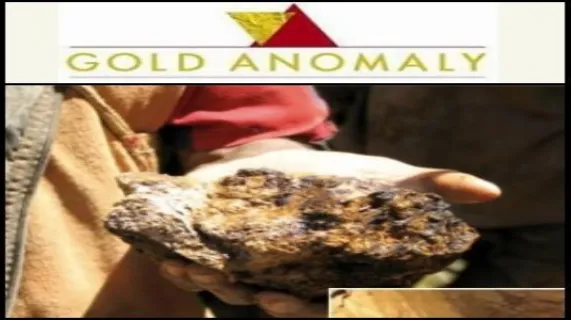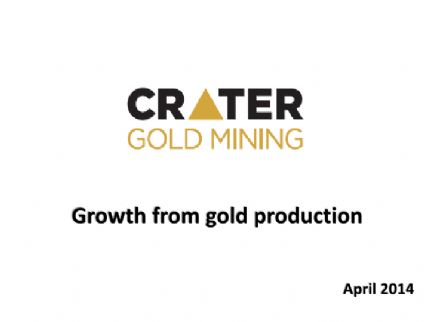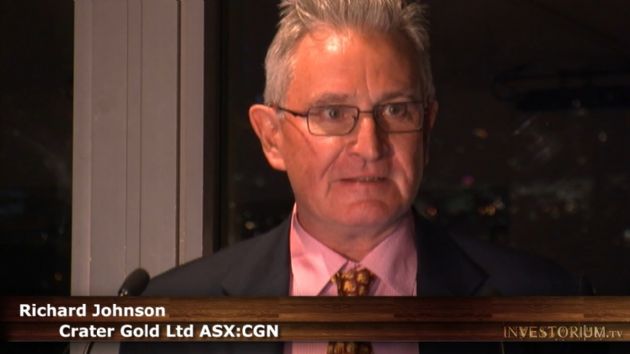
Copper Gold Porphyry Zone Further Identified
Sydney, Mar 15, 2012 AEST (ABN Newswire) - Gold Anomaly Limited ( ASX:GOA) is pleased to report assay results for their latest two drill holes, NEV030 and NEV032, at the Company's flagship Crater Mountain gold project in PNG. A detailed geological report by well renowned Pacific Rim geological consultant Dr Greg Corbett based on the drilling since February 2011 has been received.
ASX:GOA) is pleased to report assay results for their latest two drill holes, NEV030 and NEV032, at the Company's flagship Crater Mountain gold project in PNG. A detailed geological report by well renowned Pacific Rim geological consultant Dr Greg Corbett based on the drilling since February 2011 has been received.
NEV030 and NEV032 results provide important data on the possible location of the deep hot porphyry intrusion as well as the location of the mixing zone boundary. Of note, NEV032 is interpreted as having grazed the northern edge of the inferred mixing zone resource, which currently contains a 790,000 ounces gold inferred resource.
Work by Dr Corbett defined the likely controlling structure for the mixing zone carbonate-base metal sulphide-gold inferred resource and identified two new target models for drill testing:
i. porphyry copper-gold underlying the northwest quadrant of the area currently being prospected; and
ii. high grade high sulphidation quartz-pyrite-gold mineralization extending to depth below the Artisanal Mining Area.
Figure 1 shows the updated cross section of the mineralisation model of the Nevera prospect with the porphyry target identified. Figure 2 shows the long view of the Nevera prospect with target areas highlighted.
Director - Exploration Mr Peter Macnab commented, "The recent examination by consultant Dr Greg Corbett of drill core from the past 12 months drilling at Crater Mountain has led to a greatly improved understanding of the geological framework and mineralisation potential in the drilled portion of the Nevera Prospect. The work has highlighted particularly the deep porphyry coppergold potential underlying the untested northwest quadrant of the drilled area, as well as underlining the potential for high gold grades to persist to depth below the Artisanal mine site.
"Preparations have begun to recommence drilling by the end of the month, targeting both the porphyry copper-gold mineralisation with an initial +1,000m hole, and high grade gold in the roots of the Artisanal mining system with two shorter holes. The next three months promise to be an exciting time."
Dr Corbett's conclusions also stress the need to accelerate exploration over the remainder of the Nevera Prospect and other identified prospects within the Crater Mountain tenements, and to move as quickly as possible to scout drilling in those areas. To date, channel sampling and geological mapping has been undertaken on the Nimi Prospect for the past several months, and this work is ongoing. Fieldwork is currently planned for Awaunita and Masi Prospects and exploration teams assembled.
3D modelling of the mixing zone inferred resource has highlighted two relatively flat-lying high-grade gold sheets within it which remain open laterally (see Figure 4), lying towards the top and bottom of the inferred resource envelope and separated by up to 100m vertically. Grades reported from drill assays include 15m at 3.42 g/t Au (NEV002), 24m at 6.55 g/t Au (NEV005), 20m at 2.33 g/t Au (NEV008), 19m at 3.37 g/t Au (NEV018) and 26m at 4.6 g/t Au (NEV019). The dimensions of each of the high-grade sheets are inferred to be up to 300m long by 100m wide and 15m to 25m thick, and they remain open laterally.
The presence of this high-grade material, which can be mined by open pit or underground, impacts significantly on the mixing zone potential.
NEV030 Assay Results and Interpretation
NEV030 was drilled from the north of the prospected area to a depth of 1,128.1m (see Figure 3).
The drill hole was located to achieve maximum depth, ending 500m lower than the base of NEV019 and NEV024 and 150m lower and 200m distant from the base of NEV027. The hole finished more than 600m below any possible extensions of the mixing zone mineralisation, targeting the hot intrusion bleaching and altering the Chim Formation shales over hundreds of metres in the bottom sections of many earlier drill holes, and suspected to contain several porphyry apophyses which are the source of the mixing zone gold mineralisation.
NEV030 commenced in variably altered and veined andesite porphyry, passing into a broad zone of brecciation at 256m, and thence unaltered grey Chim Formation shales becoming bleached and variably propylitically altered at 342m and continuing to the bottom of the hole. The Chim Formation has been intruded by several porphyry aphosis which are commonly sericite, more rarely epidote and magnetite altered) Propylitic alteration in the Chim Formation shales is commonly green chlorite, with actinolite and magnetite identified at the bottom of the hole. Silicification is noted, particularly towards the bottom of the hole. Veining comprises quartz-pyrite (-pyrrhotite), with less common off-setting later carbonate-base metal sulphide.
Gold values in NEV030 are mostly low, with a small number of exceptions containing gold-bearing primary veins. The identified mixing zone gold mineralisation was not targeted, being located under the Prospect ridge at a higher elevation, and results are not surprising. A source porphyry event for the mixing zone gold was not located, however sporadic high gold assays deep in the hole attest to the presence of a primary feeder zone at considerable depth. The most notable assay results are 2m at 3.89 g/t Au from 594m to 596m, and 2m at 30.8g/t Au (essentially 1 ounce per tonne) from 898m to 900m. Assay results are reported below in Table 1:
Table 1 NEV030 Results-------------------------------------------------- NEV030 assay results--------------------------------------------------From (m) To (m) Interval (m) Au g/t-------------------------------------------------- 124 128 4 0.46 134 140 6 0.65 152 156 4 0.42 184 192 8 0.36 216 242 26 0.36 318 322 4 0.31 396 400 4 1.11 518 524 6 0.92 564 566 2 1.74 570 578 8 0.63 594 596 2 3.89 644 646 2 1.22 812 814 2 1.57 898 900 2 30.8 960 962 2 0.95--------------------------------------------------
The above intercepts were calculated using a 0.20g/t Au COG, using a minimum intercept width of 2m, and a maximum of 4m of internal dilution. The intercept was calculated using a weighted average, whereby the summation of the individual sample grade is multiplied by the sample width then divided by the intercept length. Each sample is of half core and each sample length is 2m.
In NEV030, Ag assay values are mostly low throughout, <2.0 g/t Ag, whilst base metal results show some systematic anomalism down the hole.
From 0m to 500m Cu is low to 130m thence sporadically anomalous to 500m, rarely in the 1,000 to 3,000 ppm range; Pb is rarely anomalous; and Zn displays sporadic long and short anomalous sections throughout.
NEV032 Assay Results and Interpretation
NEV032 was drilled between NEV025 and NEV021, (Figure 3) to look for the extension of the mixing zone mineralisation. The hole commenced in andesite porphyry and drilled through a wide intersection of mixed breccias and porphyry dykes of the Nevera Breccia Complex (see below), into bedded largely pyroclastic volcanics, before passing into bleached Chim Formation shales near the bottom of the hole, which was completed at 630.1m.
Gold values in NEV032 are lower than anticipated, possibly due to the drill hole missing the main mineralised zone and just intersecting the lower northern edge before largely passing under it. Anomalous gold values are summarised in Table 2 (below):
Table 2 NEV032 Results-------------------------------------------------- NEV032 assay results--------------------------------------------------From (m) To (m) Interval (m) Au g/t-------------------------------------------------- 60 62 2 17.7 96 100 4 0.65 198 210 12 0.56 322 366 44 0.42including 342 358 16 0.67--------------------------------------------------
The above intercepts were calculated using a 0.20g/t Au COG, using a minimum intercept width of 2m, and a maximum of 4m of internal dilution. The intercept was calculated using a weighted average, whereby the summation of the individual sample grade is multiplied by the sample width then divided by the intercept length. Each sample is of half core and each sample length is 2m.
This is confirmed by the rapidly developing 3D model which indicate that the position of the goldbearing mixing zone mineralisation in drill holes NEV025 (98m at 1.06 g/t Au) and NEV021 (54m at 0.71 g/t Au including 8m at 1.33 g/t Au) suggests that NEV032 may have clipped the lower northern edge of the gold-bearing mixing zone (322m to 366m) and drilled under the main body of mineralisation, which may have narrowed to 100m and is now interpreted as paralleling the southwest-trending Nevera Breccia Complex.
If this interpretation is correct, then it is possible that the mixing zone extends farther to the southwest as originally believed, with NEV028 and NEV029 drilling below the elongate tabular mineralised body. This possibility will be drill tested at the appropriate time.
Base metal values are mostly variably anomalous in the top 130m of the hole (except for low Zn in the uppermost 30m) then sporadically anomalous to the bottom of the hole.
New Targets Identified by drilling
Recent geological mapping of the Nevera Prospect drill core by pre-eminent consulting geologist Dr Greg Corbett and Gold Anomaly's Exploration Director Mr Peter Macnab led to the re-assessment of the lithology, distribution of alteration and structural framework of the drilled area in the north of the Prospect (Dr Corbett's full report will soon be posted on the Company's web site).
This improved understanding of the basic geological parameters that control and signpost the mineralization has led to the recognition of additional targets to the already identified low sulphidation mixing zone carbonate-base metal sulphide-gold inferred resource, comprising a possible porphyry copper-gold apophysis underlying the northwest quadrant of the prospected area (Figure 2), as well as potential high gold grades continuing to depth below the Artisanal Mining Area now identified as late stage high grade high sulphidation quartz-pyrite-gold mineralization (Figure 2).
Fundamental to the improved geological understanding of the area is the recognition and highlighting of the northeasterly-trending Nevera Breccia Complex and the northerly-trending Walkover Fault as key structural elements in the area. The Nevera Breccia Complex is a broad linear feature developed along the Nevera Fault, a re-activated old deep crustal fracture in the Chim Formation basement which with renewed movement was propagated upwards into the young overlying volcanics of the Crater Mountain stratovolcano; tectonic breccias of the Nevera Fault mixed with younger hydrothermal breccias streaming to the surface and porphyry dykes that invaded the structure in their quest to vent at the surface. The Nevera Breccia Complex is interpreted as the key structure that facilitated the passage of the rising hot mineralized magmatic fluids that mixed with carbonated ground waters to form the mixing zone inferred resource.
The Nevera Breccia Complex is cut off at its northeastern end by the Walkover Fault, which is a poorly exposed and understood system that appears in the south in the vicinity of the NEV027 collar to incorporate a steeply dipping major fault trending east of north, with a shallow westerly-dipping splay which can be mapped curving gradually round to the north-northwest in the vicinity of the NEV030 collar. Although in places the Walkover Fault comprises predominately tectonic breccias, in other places it has been hijacked by younger hydrothermal breccias similar to those of the Nevera Breccia Complex.
The best development of the mixing zone mineralization is in the vicinity of the termination of the Nevera Breccia Complex against the Walkover Fault, with the mineralisation obviously younger than the structural interaction as the mixing zone extends across and to the east of the Walkover Fault.
The porphyry copper-gold potential is identified by the distribution of propylitic (distal) and phyllic (more proximal, capping) alteration in drill core, with phyllic alteration best developed in NEV020.
Narrow zones of alteration characteristic of high sulphidation quartz-pyrite-gold mineralisation surround the steep high-grade gold "shoots" in the Artisanal Mining Area (NEV022); this style of mineralisation can extend to depths of many hundreds of metres, introducing the potential to find high grades of gold in structurally suitable hosts deep below the mining site.
Next phase drilling program planned - first three targets determined Three holes are currently planned for the next phase of drilling at Nevera:
i. a deep hole (1000m+) to test the potential porphyry copper-gold target, and
ii. two 500-600m holes to probe beneath the Artisanal mine workings.
Drilling will resume later this month.
Regional Exploration
The Company has long recognised the need to accelerate exploration over the remainder of the Nevera Prospect and conduct follow-up exploration on the other identified prospects within the Crater Mountain tenements. Exploration at the Nimi Prospect is ongoing, with channel sampling and geological mapping now completed. In addition, fieldwork has been started in the area linking the Nevera Prospect to the Masi Prospect, with positive soil and pit gold results as well as gold in pan concentrates to be followed up. The Company will move as quickly as possible to scout drilling in those areas.
Preparations for fieldwork in the Awaunita and Masi Prospects are being progressed, including liaison with landowners, planning the fieldwork and related logistics, and the sourcing of manpower.
Several other areas of known gold occurrences are also on the immediate agenda for reconnaissance surveys.
To view the complete Gold Anomaly announcement including Figures, please refer to the following link below:
http://media.abnnewswire.net/media/en/docs/ASX-GOA-240515.pdf
Contact
Gold Anomaly Limited
T: +61-2-9241-4224
F: +61-2-9252-2335
WWW: www.goldanomaly.com.au
| ||
|






